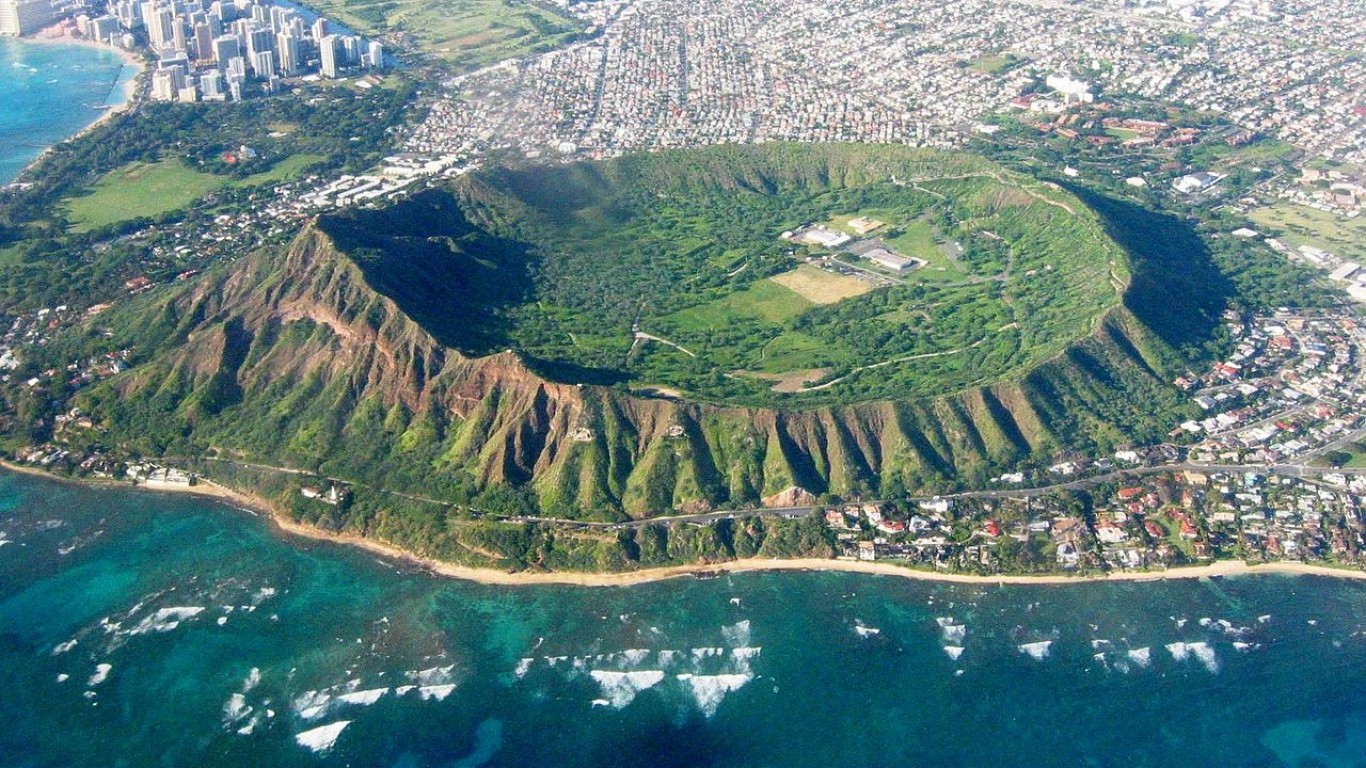Special Report
States With the Highest Number of Confirmed COVID-19 Cases

Published:

The first case of the novel coronavirus in the United States was confirmed on Jan. 21, 2020 — a healthy 35-year-old nonsmoker who had just returned to Washington state from Wuhan, China. Since then, the United States has become the epicenter of the pandemic, reporting more total cases than any other country. As of 5 p.m. on April 8, 2020, more than 420,000 people in the U.S. have been diagnosed with COVID-19, comprising about 27% of the nearly 1.5 million cases worldwide.
Physical distancing is considered the best available means to, as epidemiologists say, “flatten the curve of the pandemic” — meaning slowing down the spread of a disease. The Centers for Disease Control and Prevention recommends people maintain a distance of at least 6 feet from one another, not gather in groups, and stay out of crowded places.
The goal is to save lives and keep local health care systems from being overwhelmed, but the outbreak has spread unevenly nationwide, affecting some states much more than others. 24/7 Tempo reviewed the number of cases and death in each state as of April 8, 2020 from The New York Times and adjusted for population to identify the states with the highest coronavirus cases per capita.
New York state has reported more than 140,000 cases, more than triple the state with the second most cases of COVID-19 — New Jersey. There, just over 44,000 cases have been confirmed. The state with the fewest number of coronavirus patients is Alaska, with a total of 211 cases.
The ranking is different when the total number of coronavirus cases is adjusted for the population. For example, Minnesota has the fewest COVID-19 cases per 100,000 people but the 10th highest total of confirmed cases.
There also appears to be a correlation between population density and the number of coronavirus cases. Of the 15 states with the highest density — measured as people per square mile — 10 are also among the states with the highest number of COVID-19 cases per 100,000 people.
While the novel coronavirus outbreak is among the most serious international public health emergencies in recent memory, it may not come close to the devastation wrought by some of history’s worst outbreaks. Here are the worst outbreaks of all time.
Click here to see the states with the highest number of confirmed COVID-19 cases.
To determine the states with the highest number of COVID-19 cases, 24/7 Tempo reviewed case and death count cases as of Apr. 7, 2020 from The New York Times. Confirmed case and death counts were adjusted for population using one-year data from the U.S. Census Bureau’s 2018 American Community Survey. Data on the number of registered nurses came from the Bureau of Labor Statistics’ Occupational Employment Statistics program for May 2019, and were adjusted for population using one-year 2018 ACS data. Data on the expected peak use of resources are based on projections for the need for hospital beds for COVID-19 patients from the Institute for Health Metrics and Evaluation of the University of Washington in Seattle.

50. Minnesota
> COVID-19 confirmed cases as of 4/7/2020: 19.05 per 100,000 people (total: 1,069)
> COVID-19 related deaths as of 4/7/2020: 0.61 per 100,000 people — 21st lowest (total: 34)
> Date of the first confirmed case: March 6, 2020
> Case count seven days ago: 689
> Projected date of peak use of resources: April 23, 2020
> Projected hospital beds needed on peak date: 1,110 (4,983 beds expected to be available on peak date)
> Projected ICU beds needed on peak date: 226 (355 beds expected to be available on peak date)
> Population density: 64.5 per square mile — 20th lowest (total population: 5,611,179)
[in-text-ad]

49. West Virginia
> COVID-19 confirmed cases as of 4/7/2020: 22.81 per 100,000 people (total: 412)
> COVID-19 related deaths as of 4/7/2020: 0.22 per 100,000 people — 4th lowest (total: 4)
> Date of the first confirmed case: March 17, 2020
> Case count seven days ago: 191
> Projected date of peak use of resources: April 16, 2020
> Projected hospital beds needed on peak date: 719 (3,032 beds expected to be available on peak date)
> Projected ICU beds needed on peak date: 126 (196 beds expected to be available on peak date)
> Population density: 74.5 per square mile — 22nd lowest (total population: 1,805,832)

48. Nebraska
> COVID-19 confirmed cases as of 4/7/2020: 25.40 per 100,000 people (total: 490)
> COVID-19 related deaths as of 4/7/2020: 0.62 per 100,000 people — 9th lowest (total: 12)
> Date of the first confirmed case: Feb. 17, 2020
> Case count seven days ago: 249
> Projected date of peak use of resources: April 24, 2020
> Projected hospital beds needed on peak date: 831 (3,130 beds expected to be available on peak date)
> Projected ICU beds needed on peak date: 168 (232 beds expected to be available on peak date)
> Population density: 24.9 per square mile — 8th lowest (total population: 1,929,268)

47. Oregon
> COVID-19 confirmed cases as of 4/7/2020: 28.18 per 100,000 people (total: 1,181)
> COVID-19 related deaths as of 4/7/2020: 0.79 per 100,000 people — 20th lowest (total: 33)
> Date of the first confirmed case: Feb. 28, 2020
> Case count seven days ago: 736
> Projected date of peak use of resources: April 21, 2020
> Projected hospital beds needed on peak date: 227 (2,657 beds expected to be available on peak date)
> Projected ICU beds needed on peak date: 47 (210 beds expected to be available on peak date)
> Population density: 42.6 per square mile — 13th lowest (total population: 4,190,713)
[in-text-ad-2]

46. Alaska
> COVID-19 confirmed cases as of 4/7/2020: 28.61 per 100,000 people (total: 211)
> COVID-19 related deaths as of 4/7/2020: 0.54 per 100,000 people — 4th lowest (total: 04)
> Date of the first confirmed case: March 12, 2020
> Case count seven days ago: 143
> Projected date of peak use of resources: April 17, 2020
> Projected hospital beds needed on peak date: 780 (682 beds expected to be available on peak date)
> Projected ICU beds needed on peak date: 154 (54 beds expected to be available on peak date)
> Population density: 1.1 per square mile — the lowest (total population: 737,438)

45. Hawaii
> COVID-19 confirmed cases as of 4/7/2020: 28.72 per 100,000 people (total: 408)
> COVID-19 related deaths as of 4/7/2020: 0.35 per 100,000 people — 5th lowest (total: 05)
> Date of the first confirmed case: March 6, 2020
> Case count seven days ago: 258
> Projected date of peak use of resources: April 12, 2020
> Projected hospital beds needed on peak date: 631 (956 beds expected to be available on peak date)
> Projected ICU beds needed on peak date: 111 (45 beds expected to be available on peak date)
> Population density: 129.9 per square mile — 20th highest (total population: 1,420,491)
[in-text-ad]

44. Kentucky
> COVID-19 confirmed cases as of 4/7/2020: 28.85 per 100,000 people (total: 1,289)
> COVID-19 related deaths as of 4/7/2020: 1.48 per 100,000 people — 24th highest (total: 66)
> Date of the first confirmed case: March 6, 2020
> Case count seven days ago: 682
> Projected date of peak use of resources: April 21, 2020
> Projected hospital beds needed on peak date: 2,593 (6,210 beds expected to be available on peak date)
> Projected ICU beds needed on peak date: 503 (448 beds expected to be available on peak date)
> Population density: 110.6 per square mile — 21st highest (total population: 4,468,402)

43. Montana
> COVID-19 confirmed cases as of 4/7/2020: 30.03 per 100,000 people (total: 319)
> COVID-19 related deaths as of 4/7/2020: 0.56 per 100,000 people — 7th lowest (total: 06)
> Date of the first confirmed case: March 13, 2020
> Case count seven days ago: 217
> Projected date of peak use of resources: April 13, 2020
> Projected hospital beds needed on peak date: 45 (1,669 beds expected to be available on peak date)
> Projected ICU beds needed on peak date: 08 (85 beds expected to be available on peak date)
> Population density: 7.2 per square mile — 3rd lowest (total population: 1,062,305)

42. North Carolina
> COVID-19 confirmed cases as of 4/7/2020: 31.01 per 100,000 people (total: 3,220)
> COVID-19 related deaths as of 4/7/2020: 0.48 per 100,000 people — 22nd lowest (total: 50)
> Date of the first confirmed case: March 3, 2020
> Case count seven days ago: 1,582
> Projected date of peak use of resources: April 13, 2020
> Projected hospital beds needed on peak date: 1,361 (7,125 beds expected to be available on peak date)
> Projected ICU beds needed on peak date: 258 (567 beds expected to be available on peak date)
> Population density: 192.9 per square mile — 14th highest (total population: 10,383,620)
[in-text-ad-2]

41. Kansas
> COVID-19 confirmed cases as of 4/7/2020: 31.08 per 100,000 people (total: 905)
> COVID-19 related deaths as of 4/7/2020: 1.03 per 100,000 people — 19th lowest (total: 30)
> Date of the first confirmed case: March 7, 2020
> Case count seven days ago: 488
> Projected date of peak use of resources: April 19, 2020
> Projected hospital beds needed on peak date: 466 (4,810 beds expected to be available on peak date)
> Projected ICU beds needed on peak date: 94 (278 beds expected to be available on peak date)
> Population density: 35.4 per square mile — 10th lowest (total population: 2,911,510)

40. North Dakota
> COVID-19 confirmed cases as of 4/7/2020: 31.18 per 100,000 people (total: 237)
> COVID-19 related deaths as of 4/7/2020: 0.53 per 100,000 people — 4th lowest (total: 04)
> Date of the first confirmed case: March 11, 2020
> Case count seven days ago: 147
> Projected date of peak use of resources: April 17, 2020
> Projected hospital beds needed on peak date: 928 (1,545 beds expected to be available on peak date)
> Projected ICU beds needed on peak date: 188 (86 beds expected to be available on peak date)
> Population density: 10.8 per square mile — 4th lowest (total population: 760,077)
[in-text-ad]

39. Texas
> COVID-19 confirmed cases as of 4/7/2020: 31.27 per 100,000 people (total: 8,974)
> COVID-19 related deaths as of 4/7/2020: 0.62 per 100,000 people — 14th highest (total: 178)
> Date of the first confirmed case: Feb. 12, 2020
> Case count seven days ago: 4,261
> Projected date of peak use of resources: April 19, 2020
> Projected hospital beds needed on peak date: 3,682 (28,633 beds expected to be available on peak date)
> Projected ICU beds needed on peak date: 712 (2,259 beds expected to be available on peak date)
> Population density: 106.9 per square mile — 22nd highest (total population: 28,701,845)

38. Arkansas
> COVID-19 confirmed cases as of 4/7/2020: 33.08 per 100,000 people (total: 997)
> COVID-19 related deaths as of 4/7/2020: 0.60 per 100,000 people — 15th lowest (total: 18)
> Date of the first confirmed case: March 11, 2020
> Case count seven days ago: 624
> Projected date of peak use of resources: April 24, 2020
> Projected hospital beds needed on peak date: 500 (5,005 beds expected to be available on peak date)
> Projected ICU beds needed on peak date: 102 (394 beds expected to be available on peak date)
> Population density: 56.7 per square mile — 17th lowest (total population: 3,013,825)

37. Iowa
> COVID-19 confirmed cases as of 4/7/2020: 33.21 per 100,000 people (total: 1,048)
> COVID-19 related deaths as of 4/7/2020: 0.82 per 100,000 people — 17th lowest (total: 26)
> Date of the first confirmed case: March 8, 2020
> Case count seven days ago: 549
> Projected date of peak use of resources: April 26, 2020
> Projected hospital beds needed on peak date: 726 (4,297 beds expected to be available on peak date)
> Projected ICU beds needed on peak date: 150 (246 beds expected to be available on peak date)
> Population density: 56.1 per square mile — 15th lowest (total population: 3,156,145)
[in-text-ad-2]

36. Arizona
> COVID-19 confirmed cases as of 4/7/2020: 35.91 per 100,000 people (total: 2,575)
> COVID-19 related deaths as of 4/7/2020: 1.07 per 100,000 people — 20th highest (total: 77)
> Date of the first confirmed case: Jan. 26, 2020
> Case count seven days ago: 1,413
> Projected date of peak use of resources: April 23, 2020
> Projected hospital beds needed on peak date: 856 (6,017 beds expected to be available on peak date)
> Projected ICU beds needed on peak date: 177 (508 beds expected to be available on peak date)
> Population density: 62.9 per square mile — 19th lowest (total population: 7,171,646)

35. South Dakota
> COVID-19 confirmed cases as of 4/7/2020: 36.27 per 100,000 people (total: 320)
> COVID-19 related deaths as of 4/7/2020: 0.68 per 100,000 people — 7th lowest (total: 06)
> Date of the first confirmed case: March 10, 2020
> Case count seven days ago: 129
> Projected date of peak use of resources: April 25, 2020
> Projected hospital beds needed on peak date: 374 (1,805 beds expected to be available on peak date)
> Projected ICU beds needed on peak date: 73 (74 beds expected to be available on peak date)
> Population density: 11.4 per square mile — 5th lowest (total population: 882,235)
[in-text-ad]

34. Oklahoma
> COVID-19 confirmed cases as of 4/7/2020: 37.33 per 100,000 people (total: 1,472)
> COVID-19 related deaths as of 4/7/2020: 1.70 per 100,000 people — 23rd highest (total: 67)
> Date of the first confirmed case: March 6, 2020
> Case count seven days ago: 719
> Projected date of peak use of resources: April 22, 2020
> Projected hospital beds needed on peak date: 1,391 (5,457 beds expected to be available on peak date)
> Projected ICU beds needed on peak date: 282 (467 beds expected to be available on peak date)
> Population density: 56.4 per square mile — 16th lowest (total population: 3,943,079)

33. New Mexico
> COVID-19 confirmed cases as of 4/7/2020: 37.89 per 100,000 people (total: 794)
> COVID-19 related deaths as of 4/7/2020: 0.62 per 100,000 people — 12th lowest (total: 13)
> Date of the first confirmed case: March 11, 2020
> Case count seven days ago: 363
> Projected date of peak use of resources: April 21, 2020
> Projected hospital beds needed on peak date: 1,218 (1,752 beds expected to be available on peak date)
> Projected ICU beds needed on peak date: 247 (117 beds expected to be available on peak date)
> Population density: 17.2 per square mile — 6th lowest (total population: 2,095,428)

32. Wyoming
> COVID-19 confirmed cases as of 4/7/2020: 38.25 per 100,000 people (total: 221)
> COVID-19 related deaths as of 4/7/2020: 0.00 per 100,000 people — the lowest (total: 0)
> Date of the first confirmed case: March 11, 2020
> Case count seven days ago: 137
> Projected date of peak use of resources: April 29, 2020
> Projected hospital beds needed on peak date: 258 (1,069 beds expected to be available on peak date)
> Projected ICU beds needed on peak date: 52 (44 beds expected to be available on peak date)
> Population density: 5.9 per square mile — 2nd lowest (total population: 577,737)
[in-text-ad-2]

31. Maine
> COVID-19 confirmed cases as of 4/7/2020: 38.78 per 100,000 people (total: 519)
> COVID-19 related deaths as of 4/7/2020: 0.90 per 100,000 people — 9th lowest (total: 12)
> Date of the first confirmed case: March 12, 2020
> Case count seven days ago: 344
> Projected date of peak use of resources: April 15, 2020
> Projected hospital beds needed on peak date: 277 (1,061 beds expected to be available on peak date)
> Projected ICU beds needed on peak date: 55 (64 beds expected to be available on peak date)
> Population density: 37.8 per square mile — 12th lowest (total population: 1,338,404)

30. Virginia
> COVID-19 confirmed cases as of 4/7/2020: 39.13 per 100,000 people (total: 3,333)
> COVID-19 related deaths as of 4/7/2020: 0.81 per 100,000 people — 22nd highest (total: 69)
> Date of the first confirmed case: March 7, 2020
> Case count seven days ago: 1,511
> Projected date of peak use of resources: April 20, 2020
> Projected hospital beds needed on peak date: 2,854 (6,581 beds expected to be available on peak date)
> Projected ICU beds needed on peak date: 560 (329 beds expected to be available on peak date)
> Population density: 199.1 per square mile — 13th highest (total population: 8,517,685)
[in-text-ad]

29. Ohio
> COVID-19 confirmed cases as of 4/7/2020: 40.91 per 100,000 people (total: 4,782)
> COVID-19 related deaths as of 4/7/2020: 1.43 per 100,000 people — 16th highest (total: 167)
> Date of the first confirmed case: March 9, 2020
> Case count seven days ago: 2,547
> Projected date of peak use of resources: April 8, 2020
> Projected hospital beds needed on peak date: 1,372 (14,290 beds expected to be available on peak date)
> Projected ICU beds needed on peak date: 262 (1,238 beds expected to be available on peak date)
> Population density: 260.8 per square mile — 10th highest (total population: 11,689,442)

28. California
> COVID-19 confirmed cases as of 4/7/2020: 44.34 per 100,000 people (total: 17,540)
> COVID-19 related deaths as of 4/7/2020: 1.13 per 100,000 people — 5th highest (total: 447)
> Date of the first confirmed case: Jan. 25, 2020
> Case count seven days ago: 9,816
> Projected date of peak use of resources: April 14, 2020
> Projected hospital beds needed on peak date: 4,869 (26,654 beds expected to be available on peak date)
> Projected ICU beds needed on peak date: 798 (1,993 beds expected to be available on peak date)
> Population density: 241.7 per square mile — 11th highest (total population: 39,557,045)

27. Wisconsin
> COVID-19 confirmed cases as of 4/7/2020: 44.34 per 100,000 people (total: 2,578)
> COVID-19 related deaths as of 4/7/2020: 1.62 per 100,000 people — 18th highest (total: 94)
> Date of the first confirmed case: Feb. 5, 2020
> Case count seven days ago: 1,550
> Projected date of peak use of resources: April 17, 2020
> Projected hospital beds needed on peak date: 1,514 (5,364 beds expected to be available on peak date)
> Projected ICU beds needed on peak date: 302 (172 beds expected to be available on peak date)
> Population density: 88.8 per square mile — 24th lowest (total population: 5,813,568)
[in-text-ad-2]

26. Alabama
> COVID-19 confirmed cases as of 4/7/2020: 44.95 per 100,000 people (total: 2,197)
> COVID-19 related deaths as of 4/7/2020: 1.31 per 100,000 people — 25th highest (total: 64)
> Date of the first confirmed case: March 13, 2020
> Case count seven days ago: 1,106
> Projected date of peak use of resources: April 18, 2020
> Projected hospital beds needed on peak date: 2,052 (5,743 beds expected to be available on peak date)
> Projected ICU beds needed on peak date: 400 (474 beds expected to be available on peak date)
> Population density: 93.2 per square mile — 25th highest (total population: 4,887,871)

25. South Carolina
> COVID-19 confirmed cases as of 4/7/2020: 47.54 per 100,000 people (total: 2,417)
> COVID-19 related deaths as of 4/7/2020: 1.00 per 100,000 people — 23rd lowest (total: 51)
> Date of the first confirmed case: March 6, 2020
> Case count seven days ago: 1,293
> Projected date of peak use of resources: April 24, 2020
> Projected hospital beds needed on peak date: 692 (4,679 beds expected to be available on peak date)
> Projected ICU beds needed on peak date: 140 (404 beds expected to be available on peak date)
> Population density: 158.8 per square mile — 18th highest (total population: 5,084,127)
[in-text-ad]
24. Missouri
> COVID-19 confirmed cases as of 4/7/2020: 49.57 per 100,000 people (total: 3,037)
> COVID-19 related deaths as of 4/7/2020: 1.29 per 100,000 people — 19th highest (total: 79)
> Date of the first confirmed case: March 7, 2020
> Case count seven days ago: 1,581
> Projected date of peak use of resources: April 19, 2020
> Projected hospital beds needed on peak date: 562 (7,933 beds expected to be available on peak date)
> Projected ICU beds needed on peak date: 112 (558 beds expected to be available on peak date)
> Population density: 87.9 per square mile — 23rd lowest (total population: 6,126,452)

23. New Hampshire
> COVID-19 confirmed cases as of 4/7/2020: 55.07 per 100,000 people (total: 747)
> COVID-19 related deaths as of 4/7/2020: 0.96 per 100,000 people — 12th lowest (total: 13)
> Date of the first confirmed case: March 2, 2020
> Case count seven days ago: 415
> Projected date of peak use of resources: April 15, 2020
> Projected hospital beds needed on peak date: 84 (1,018 beds expected to be available on peak date)
> Projected ICU beds needed on peak date: 15 (83 beds expected to be available on peak date)
> Population density: 145.1 per square mile — 19th highest (total population: 1,356,458)

22. Utah
> COVID-19 confirmed cases as of 4/7/2020: 55.42 per 100,000 people (total: 1,752)
> COVID-19 related deaths as of 4/7/2020: 0.41 per 100,000 people — 12th lowest (total: 13)
> Date of the first confirmed case: Feb. 25, 2020
> Case count seven days ago: 1,012
> Projected date of peak use of resources: April 25, 2020
> Projected hospital beds needed on peak date: 329 (2,771 beds expected to be available on peak date)
> Projected ICU beds needed on peak date: 66 (170 beds expected to be available on peak date)
> Population density: 37.2 per square mile — 11th lowest (total population: 3,161,105)
[in-text-ad-2]

21. Tennessee
> COVID-19 confirmed cases as of 4/7/2020: 59.23 per 100,000 people (total: 4,010)
> COVID-19 related deaths as of 4/7/2020: 1.06 per 100,000 people — 21st highest (total: 72)
> Date of the first confirmed case: March 5, 2020
> Case count seven days ago: 2,690
> Projected date of peak use of resources: April 15, 2020
> Projected hospital beds needed on peak date: 1,232 (7,812 beds expected to be available on peak date)
> Projected ICU beds needed on peak date: 245 (629 beds expected to be available on peak date)
> Population density: 160.6 per square mile — 17th highest (total population: 6,770,010)

20. Mississippi
> COVID-19 confirmed cases as of 4/7/2020: 64.12 per 100,000 people (total: 1,915)
> COVID-19 related deaths as of 4/7/2020: 1.98 per 100,000 people — 24th lowest (total: 59)
> Date of the first confirmed case: March 11, 2020
> Case count seven days ago: 1,073
> Projected date of peak use of resources: April 18, 2020
> Projected hospital beds needed on peak date: 398 (5,733 beds expected to be available on peak date)
> Projected ICU beds needed on peak date: 81 (340 beds expected to be available on peak date)
> Population density: 61.7 per square mile — 18th lowest (total population: 2,986,530)
[in-text-ad]

19. Idaho
> COVID-19 confirmed cases as of 4/7/2020: 68.98 per 100,000 people (total: 1,210)
> COVID-19 related deaths as of 4/7/2020: 0.86 per 100,000 people — 13th lowest (total: 15)
> Date of the first confirmed case: March 13, 2020
> Case count seven days ago: 669
> Projected date of peak use of resources: April 14, 2020
> Projected hospital beds needed on peak date: 151 (1,817 beds expected to be available on peak date)
> Projected ICU beds needed on peak date: 31 (151 beds expected to be available on peak date)
> Population density: 21.0 per square mile — 7th lowest (total population: 1,754,208)

18. Florida
> COVID-19 confirmed cases as of 4/7/2020: 69.20 per 100,000 people (total: 14,739)
> COVID-19 related deaths as of 4/7/2020: 1.39 per 100,000 people — 10th highest (total: 295)
> Date of the first confirmed case: March 1, 2020
> Case count seven days ago: 7,765
> Projected date of peak use of resources: April 21, 2020
> Projected hospital beds needed on peak date: 13,168 (20,184 beds expected to be available on peak date)
> Projected ICU beds needed on peak date: 2,464 (1,695 beds expected to be available on peak date)
> Population density: 323.9 per square mile — 8th highest (total population: 21,299,325)

17. Nevada
> COVID-19 confirmed cases as of 4/7/2020: 69.24 per 100,000 people (total: 2,101)
> COVID-19 related deaths as of 4/7/2020: 1.98 per 100,000 people — 25th lowest (total: 60)
> Date of the first confirmed case: March 5, 2020
> Case count seven days ago: 1,279
> Projected date of peak use of resources: April 18, 2020
> Projected hospital beds needed on peak date: 2,490 (2,247 beds expected to be available on peak date)
> Projected ICU beds needed on peak date: 483 (183 beds expected to be available on peak date)
> Population density: 27.4 per square mile — 9th lowest (total population: 3,034,392)
[in-text-ad-2]

16. Maryland
> COVID-19 confirmed cases as of 4/7/2020: 72.33 per 100,000 people (total: 4,371)
> COVID-19 related deaths as of 4/7/2020: 1.72 per 100,000 people — 17th highest (total: 104)
> Date of the first confirmed case: March 5, 2020
> Case count seven days ago: 1,985
> Projected date of peak use of resources: April 18, 2020
> Projected hospital beds needed on peak date: 6,443 (3,961 beds expected to be available on peak date)
> Projected ICU beds needed on peak date: 1,224 (266 beds expected to be available on peak date)
> Population density: 487.1 per square mile — 5th highest (total population: 6,042,718)

15. Indiana
> COVID-19 confirmed cases as of 4/7/2020: 82.29 per 100,000 people (total: 5,507)
> COVID-19 related deaths as of 4/7/2020: 2.59 per 100,000 people — 15th highest (total: 173)
> Date of the first confirmed case: March 6, 2020
> Case count seven days ago: 2,565
> Projected date of peak use of resources: April 17, 2020
> Projected hospital beds needed on peak date: 4,441 (8,485 beds expected to be available on peak date)
> Projected ICU beds needed on peak date: 865 (706 beds expected to be available on peak date)
> Population density: 183.7 per square mile — 15th highest (total population: 6,691,878)
[in-text-ad]

14. Georgia
> COVID-19 confirmed cases as of 4/7/2020: 87.04 per 100,000 people (total: 9,156)
> COVID-19 related deaths as of 4/7/2020: 3.31 per 100,000 people — 9th highest (total: 348)
> Date of the first confirmed case: March 2, 2020
> Case count seven days ago: 4,748
> Projected date of peak use of resources: April 20, 2020
> Projected hospital beds needed on peak date: 6,824 (8,322 beds expected to be available on peak date)
> Projected ICU beds needed on peak date: 1,332 (589 beds expected to be available on peak date)
> Population density: 177.0 per square mile — 16th highest (total population: 10,519,475)

13. Vermont
> COVID-19 confirmed cases as of 4/7/2020: 91.81 per 100,000 people (total: 575)
> COVID-19 related deaths as of 4/7/2020: 3.67 per 100,000 people — 16th lowest (total: 23)
> Date of the first confirmed case: March 7, 2020
> Case count seven days ago: 321
> Projected date of peak use of resources: April 23, 2020
> Projected hospital beds needed on peak date: 69 (533 beds expected to be available on peak date)
> Projected ICU beds needed on peak date: 13 (34 beds expected to be available on peak date)
> Population density: 65.1 per square mile — 21st lowest (total population: 626,299)

12. Colorado
> COVID-19 confirmed cases as of 4/7/2020: 95.32 per 100,000 people (total: 5,429)
> COVID-19 related deaths as of 4/7/2020: 3.14 per 100,000 people — 13th highest (total: 179)
> Date of the first confirmed case: March 5, 2020
> Case count seven days ago: 3,346
> Projected date of peak use of resources: April 4, 2020
> Projected hospital beds needed on peak date: 764 (4,851 beds expected to be available on peak date)
> Projected ICU beds needed on peak date: 133 (554 beds expected to be available on peak date)
> Population density: 54.7 per square mile — 14th lowest (total population: 5,695,564)
[in-text-ad-2]

11. Delaware
> COVID-19 confirmed cases as of 4/7/2020: 95.95 per 100,000 people (total: 928)
> COVID-19 related deaths as of 4/7/2020: 1.65 per 100,000 people — 14th lowest (total: 16)
> Date of the first confirmed case: March 11, 2020
> Case count seven days ago: 368
> Projected date of peak use of resources: April 5, 2020
> Projected hospital beds needed on peak date: 127 (696 beds expected to be available on peak date)
> Projected ICU beds needed on peak date: 24 (41 beds expected to be available on peak date)
> Population density: 388.6 per square mile — 6th highest (total population: 967,171)

10. Illinois
> COVID-19 confirmed cases as of 4/7/2020: 106.34 per 100,000 people (total: 13,549)
> COVID-19 related deaths as of 4/7/2020: 3.01 per 100,000 people — 7th highest (total: 384)
> Date of the first confirmed case: Jan. 24, 2020
> Case count seven days ago: 6,980
> Projected date of peak use of resources: April 16, 2020
> Projected hospital beds needed on peak date: 9,255 (14,552 beds expected to be available on peak date)
> Projected ICU beds needed on peak date: 1,853 (1,131 beds expected to be available on peak date)
> Population density: 220.0 per square mile — 12th highest (total population: 12,741,080)
[in-text-ad]

9. Pennsylvania
> COVID-19 confirmed cases as of 4/7/2020: 113.86 per 100,000 people (total: 14,582)
> COVID-19 related deaths as of 4/7/2020: 1.87 per 100,000 people — 12th highest (total: 240)
> Date of the first confirmed case: March 6, 2020
> Case count seven days ago: 5,805
> Projected date of peak use of resources: April 11, 2020
> Projected hospital beds needed on peak date: 1,715 (14,395 beds expected to be available on peak date)
> Projected ICU beds needed on peak date: 314 (1,043 beds expected to be available on peak date)
> Population density: 278.1 per square mile — 9th highest (total population: 12,807,060)

8. Washington
> COVID-19 confirmed cases as of 4/7/2020: 115.21 per 100,000 people (total: 8,682)
> COVID-19 related deaths as of 4/7/2020: 5.43 per 100,000 people — 6th highest (total: 409)
> Date of the first confirmed case: Jan. 21, 2020
> Case count seven days ago: 5,588
> Projected date of peak use of resources: April 2, 2020
> Projected hospital beds needed on peak date: 972 (4,907 beds expected to be available on peak date)
> Projected ICU beds needed on peak date: 185 (341 beds expected to be available on peak date)
> Population density: 105.7 per square mile — 23rd highest (total population: 7,535,591)

7. Rhode Island
> COVID-19 confirmed cases as of 4/7/2020: 116.24 per 100,000 people (total: 1,229)
> COVID-19 related deaths as of 4/7/2020: 2.84 per 100,000 people — 19th lowest (total: 30)
> Date of the first confirmed case: March 1, 2020
> Case count seven days ago: 566
> Projected date of peak use of resources: April 27, 2020
> Projected hospital beds needed on peak date: 1,649 (795 beds expected to be available on peak date)
> Projected ICU beds needed on peak date: 334 (41 beds expected to be available on peak date)
> Population density: 684.3 per square mile — 2nd highest (total population: 1,057,315)
[in-text-ad-2]

6. Michigan
> COVID-19 confirmed cases as of 4/7/2020: 188.60 per 100,000 people (total: 18,852)
> COVID-19 related deaths as of 4/7/2020: 8.45 per 100,000 people — 3rd highest (total: 845)
> Date of the first confirmed case: March 10, 2020
> Case count seven days ago: 9,293
> Projected date of peak use of resources: April 8, 2020
> Projected hospital beds needed on peak date: 8,674 (10,154 beds expected to be available on peak date)
> Projected ICU beds needed on peak date: 1,652 (742 beds expected to be available on peak date)
> Population density: 103.4 per square mile — 24th highest (total population: 9,995,915)

5. Connecticut
> COVID-19 confirmed cases as of 4/7/2020: 217.79 per 100,000 people (total: 7,781)
> COVID-19 related deaths as of 4/7/2020: 7.75 per 100,000 people — 11th highest (total: 277)
> Date of the first confirmed case: March 8, 2020
> Case count seven days ago: 3,557
> Projected date of peak use of resources: April 21, 2020
> Projected hospital beds needed on peak date: 9,226 (1,738 beds expected to be available on peak date)
> Projected ICU beds needed on peak date: 1,850 (99 beds expected to be available on peak date)
> Population density: 644.5 per square mile — 4th highest (total population: 3,572,665)
[in-text-ad]

4. Massachusetts
> COVID-19 confirmed cases as of 4/7/2020: 220.25 per 100,000 people (total: 15,202)
> COVID-19 related deaths as of 4/7/2020: 5.16 per 100,000 people — 8th highest (total: 356)
> Date of the first confirmed case: Feb. 1, 2020
> Case count seven days ago: 7,738
> Projected date of peak use of resources: April 18, 2020
> Projected hospital beds needed on peak date: 13,256 (4,848 beds expected to be available on peak date)
> Projected ICU beds needed on peak date: 3,022 (277 beds expected to be available on peak date)
> Population density: 654.0 per square mile — 3rd highest (total population: 6,902,149)

3. Louisiana
> COVID-19 confirmed cases as of 4/7/2020: 349.44 per 100,000 people (total: 16,284)
> COVID-19 related deaths as of 4/7/2020: 12.49 per 100,000 people — 4th highest (total: 582)
> Date of the first confirmed case: March 9, 2020
> Case count seven days ago: 6,424
> Projected date of peak use of resources: April 1, 2020
> Projected hospital beds needed on peak date: 1,386 (7,204 beds expected to be available on peak date)
> Projected ICU beds needed on peak date: 337 (477 beds expected to be available on peak date)
> Population density: 89.0 per square mile — 25th lowest (total population: 4,659,978)

2. New Jersey
> COVID-19 confirmed cases as of 4/7/2020: 498.58 per 100,000 people (total: 44,416)
> COVID-19 related deaths as of 4/7/2020: 13.83 per 100,000 people — 2nd highest (total: 1,232)
> Date of the first confirmed case: March 4, 2020
> Case count seven days ago: 22,255
> Projected date of peak use of resources: April 15, 2020
> Projected hospital beds needed on peak date: 24,702 (7,815 beds expected to be available on peak date)
> Projected ICU beds needed on peak date: 4,992 (465 beds expected to be available on peak date)
> Population density: 1,021.3 per square mile — the highest (total population: 8,908,520)
[in-text-ad-2]

1. New York
> COVID-19 confirmed cases as of 4/7/2020: 716.81 per 100,000 people (total: 140,081)
> COVID-19 related deaths as of 4/7/2020: 28.47 per 100,000 people — the highest (total: 5,563)
> Date of the first confirmed case: March 1, 2020
> Case count seven days ago: 83,889
> Projected date of peak use of resources: April 8, 2020
> Projected hospital beds needed on peak date: 25,486 (13,010 beds expected to be available on peak date)
> Projected ICU beds needed on peak date: 6,664 (718 beds expected to be available on peak date)
> Population density: 358.2 per square mile — 7th highest (total population: 19,542,209)
Credit card companies are handing out rewards and benefits to win the best customers. A good cash back card can be worth thousands of dollars a year in free money, not to mention other perks like travel, insurance, and access to fancy lounges. See our top picks for the best credit cards today. You won’t want to miss some of these offers.
Flywheel Publishing has partnered with CardRatings for our coverage of credit card products. Flywheel Publishing and CardRatings may receive a commission from card issuers.
Thank you for reading! Have some feedback for us?
Contact the 24/7 Wall St. editorial team.